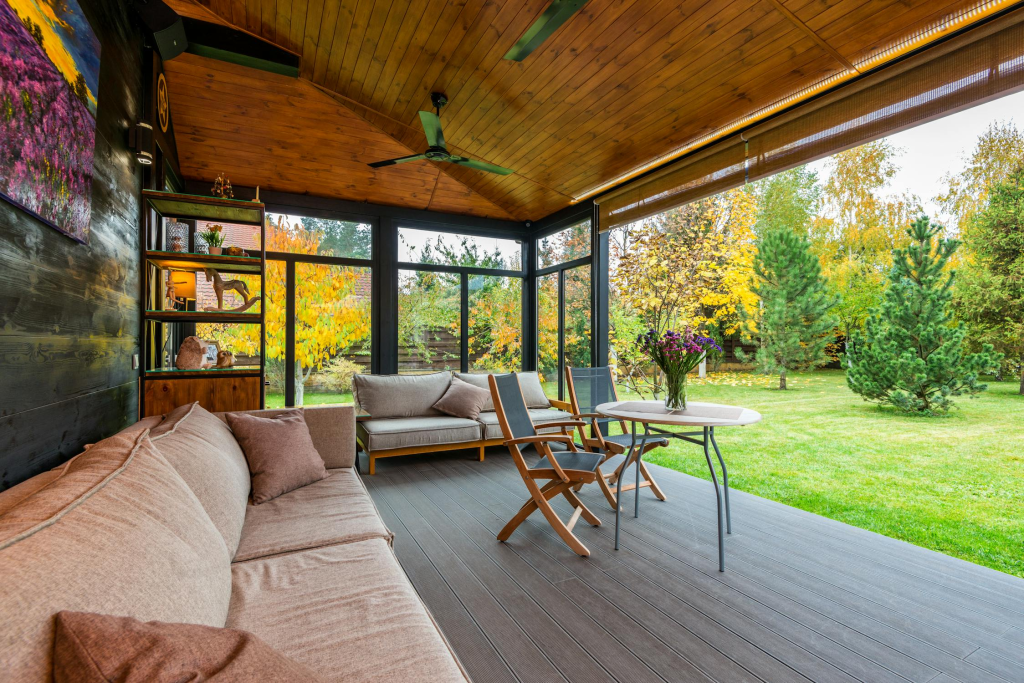Building a functional and stylish outdoor verandah can transform your living space, providing an area where you can relax, entertain guests, or simply enjoy the beauty of nature. Whether you have a large backyard or a small courtyard, creating a verandah that blends seamlessly with your home and the environment can significantly enhance your outdoor lifestyle.

This article will explore the essential steps in designing and constructing a practical and aesthetically pleasing verandah.
Bowies Verandah Builders offers exceptional services for expert design and construction, helping to bring your ideal outdoor space to life.
Factors To Consider For Outdoor Verandah Design
A verandah extends your home, offering additional space for leisure activities while protecting you from the elements. When building a verandah, consider several factors to ensure it meets your needs and design preferences.
Choosing The Right Location
The location of your verandah is critical to its functionality and comfort. Ideally, it should be placed in an area that receives ample natural light but is also shielded from extreme weather conditions. Look for a spot readily accessible from your home’s main living area. This makes it convenient for family gatherings or entertaining guests.
Selecting The Perfect Materials
The materials you choose for your verandah will determine its aesthetic appeal and durability. Opt for materials that blend with your home’s architecture and withstand the local climate. Timber is popular for its natural look, while metal and composite materials offer low-maintenance solutions.
- Timber: Offers a classic, rustic look that can be stained or painted to suit your style. It provides warmth and texture to the verandah.
- Metal: Lightweight and durable, metal verandahs resist the elements and offer a contemporary feel.
- Composite materials: A great option for those seeking a low-maintenance solution that replicates the look of wood but is more durable and weather-resistant.
Step-By-Step Guide To Building A Stylish Outdoor Verandah
Once you have a clear vision for your verandah, the next step is to plan and build it. This section will guide you through creating a functional and stylish verandah.
Step 1: Design And Planning
Before you start building, it’s essential to have a well-thought-out plan. This includes determining the size, layout, and style of your verandah. Draw up detailed plans that include measurements, structural elements, and the type of roofing.
Things to consider during planning:
- Size: Your verandah should be large enough to serve its intended purpose. Plan whether you want a place to entertain guests or simply a cosy retreat.
- Style: Think about the style of your home and how the verandah can complement it. A modern, minimalist design might work well with contemporary homes, while a traditional or country-style verandah might suit more rustic dwellings.
- Functionality: Consider the activities for which you plan to use the verandah. Will it be an outdoor dining space, a relaxation area, or a play area for children? Your usage will dictate how you design the space.
Step 2: Set A Budget
Establishing a budget is an important step before beginning any construction project. Determine how much you will spend on materials, labour, and other costs. If you plan on outfitting the verandah after it is built, factor in the cost of furniture and decor.
Step 3: Build The Foundation
The foundation of your verandah is crucial for its stability and longevity. Depending on the size and design, the foundation could be as simple as concrete slabs or as complex as a raised timber deck.
- Concrete slabs: Ideal for level ground and provide a solid foundation for your structure.
- Timber deck: A timber deck is a suitable foundation for a raised verandah that enhances the space’s overall aesthetic.
Step 4: Install The Framework
Once the foundation is ready, it’s time to build the frame. This includes the support posts, beams, and rafters. Ensure that the frame is level and properly secured to avoid any structural issues in the future. If you lack confidence in your carpentry skills, consider hiring a professional.
Step 5: Add The Roof
The roof is one of the most important elements of the verandah, as it provides shelter from the sun and rain. Choose a roofing material that suits your climate and complements the style of your home.
- Gable roof: A pitched roof allows for better ventilation and water drainage.
- Flat roof: Ideal for modern designs, providing a sleek and minimalist look.
- Lattice roof: Offers a more open feel, allowing some light to filter through while still offering protection from the sun.
Step 6: Furnishing And Decor
Now that the structure is complete, it’s time to furnish and decorate your verandah. This is where you can get creative and personalise the space. Choose comfortable outdoor furniture that suits the purpose of your verandah. For example, opt for a sturdy dining table and chairs if you plan to use it as a dining area.
Key elements to include:
- Seating: Comfortable outdoor seating, such as lounges, armchairs, or hammocks, can enhance the comfort of the space.
- Lighting: Outdoor lighting is crucial for creating an inviting atmosphere. String lights, lanterns, or wall-mounted fixtures can all add charm to the space.
- Rugs and cushions: Add warmth and texture to your verandah with outdoor rugs and pillows in complementary colours.
- Plants: Incorporate greenery to soften the space and create a more natural environment. Potted plants, hanging baskets, or climbing vines can add life to your verandah.
Conclusion
Building a functional and stylish outdoor verandah is a rewarding project that can enhance the appeal and usability of your outdoor space. By carefully considering factors like location, materials, design, and functionality, you can create a verandah that complements your home and provides a comfortable space for relaxation and entertainment.
Whether building a large, luxurious verandah or working with a smaller area, thoughtful planning and attention to detail will ensure that your outdoor space meets your needs and becomes a cherished part of your home.
Frequently Asked Questions
What Is The Best Material For An Outdoor Verandah?
The best material for an outdoor verandah depends on your climate and aesthetic preferences. Timber offers a classic, warm look, while metal provides a sleek and durable option for modern designs. Composite materials are a great low-maintenance alternative, mimicking the appearance of wood but with added durability against the elements. Choose a material that aligns with your home’s style and the local weather conditions for long-lasting results.
How Can I Make The Most Of A Small Verandah Space?
To maximise a small verandah, use multi-functional furniture like foldable tables or storage benches, which save space while serving multiple purposes. Light colours on furniture and decor can make the area feel larger, and vertical gardens or wall-mounted shelves help add greenery and storage without cluttering the floor. Keeping the design simple and uncluttered is key to creating a spacious feel in small areas.
What Are Some Design Tips For A Functional Outdoor Verandah?
A functional outdoor verandah should have a straightforward layout that fits your intended purpose, whether for dining, relaxing, or entertaining. Comfortable seating, adequate lighting, and greenery can make the space inviting. Ensure that the verandah is well-protected from the elements with the right roofing material and is located in a place with natural light yet shielded from harsh weather conditions.
